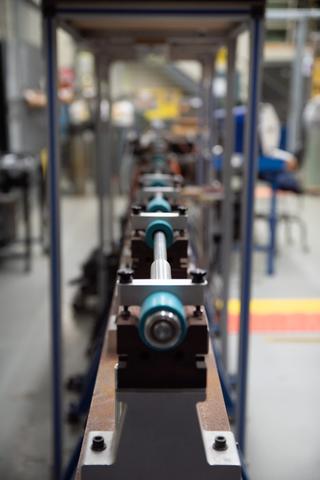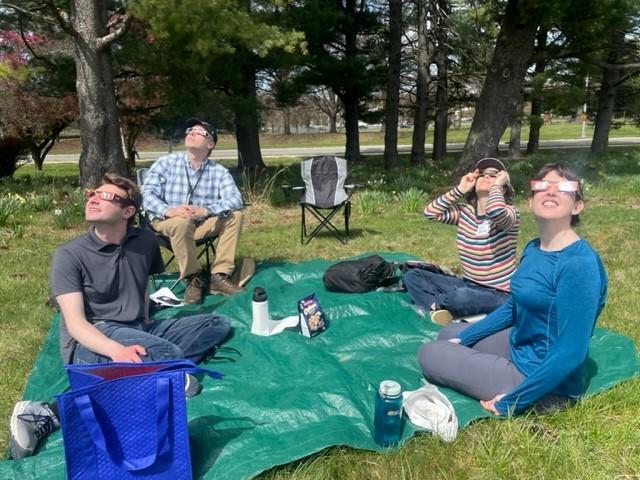Taking Measure
Just a Standard Blog
Research done at NIST is more than a measurement or a simple calculation.
Whether it’s researchers using a unique test instrument to mimic instantaneous moments that happen in a fraction of a second or monitoring greenhouse gases during a rare event, the work done here has a connection to real-world applications.
Check out some of the things happening at NIST during the past few months through the lens of social media.
Not Your Average Bar: Testing Materials Under Forces at High Speeds

This elongated test instrument, the first of its kind in the world, puts materials under two extreme conditions in fractions of seconds, rapidly heating them and applying force at the same time. It’s a modified version of a Kolsky bar, an instrument with origins dating back to the turn of the 20th century.
The Kolsky bar is set up with a long set of steel cylinders as shown here. A sample sits between them. Thin metal bars rest inside the cylinder on one side. When we strike one end with a projectile propelled by nitrogen gas, it creates a pressure wave that moves through the bars at the speed of sound in steel (way faster than a bullet) and hits the sample.
NIST’s Kolsky bar was designed to rapidly heat up the sample before the pressure wave hits it. That means we can make measurements on materials as they are weakening or changing structure at the molecular level (the microstructure) from the heat.
It’s a type of measurement that had never been attempted elsewhere in the world before NIST got involved.
But why put these materials through the wringer so fast? That’s because some major moments in life happen in fractions of seconds — car accidents, manufacturing processes, bomb explosions, athlete collisions — and we need to know how the materials that we use in everything from cars to sports helmets perform in those brief moments.
That’s especially true for products made via additive manufacturing, also known as 3D printing, the process of building a shape from the ground up, one layer of material at a time. It’s a relatively new process for creating parts to go, for example, in a car.
Thanks to the Kolsky bar experiments happening at NIST, we can gather crucial data on these parts to see how they stand up to extreme, real-world conditions.
From Skepticism to Belief: Tasshi Dennis Builds the Next Generation of Quantum Networks

When NIST scientist Tasshi Dennis first encountered quantum physics as a student, he was skeptical it would ever amount to any practical applications. Little did he know that decades later, he would be at the forefront of NIST's efforts to build the next generation of quantum computers and networks.
Tasshi’s path to quantum research was an unlikely one. In high school, his uncle, a medical doctor, tried to inspire him into a science career by gifting him a subscription to Scientific American magazine. He recalls that the articles in the magazine were hard to understand at the time, but there were a few topics that really stuck out to him, such as scientists making micromachines through a process called nanofabrication, and exotic new devices, including quantum wires and dots.
Intrigued, Tasshi decided to focus on optics and lasers in college, seeing them as a gateway into the nanofabrication world. After earning his Ph.D., he joined NIST, working on a wide range of projects from wavelength standards to biomedical imaging. “I always saw the quantum stuff happening around me, but I kind of ignored it,” he says. “I thought it was just a quirky intellectual thing that would never amount to anything.”
That changed in 2019 when NIST launched a project to demonstrate a quantum network, which is a way of connecting quantum computers and devices, similar to how classical computers are networked today. Five years later, Tasshi serves as the project leader, developing the technology to network superconducting quantum computers — a critical step toward large-scale quantum computing.
While he acknowledges that the technology is still decades away from widespread use, he’s embraced the challenge. “I’m willing to take on the risk,” he says. “I am training the next generation of scientists, but I’m learning it alongside them, which makes it really exciting.”
It’s a far cry from the young Tasshi who dismissed quantum as an intellectual curiosity. But as he’s discovered, sometimes the most promising opportunities lie in the places we least expect.
Experiencing a Solar Eclipse With Science on the Mind

Depending on where you were during the solar eclipse in April, you may have been able to witness something that only happens every so often. At our Gaithersburg, Maryland, campus, a few NIST researchers watched the solar event with science on their minds.
During the day, plants undergo photosynthesis, during which they absorb sunlight and carbon dioxide or CO2 to create food and energy, lowering CO2 concentrations in the local atmosphere. The group of researchers, which included Tyler Boyle, Anna Karion, David Allen and Julia Marrs, were curious as to whether their sensors would detect any changes to the concentration of CO2 during an eclipse.
To investigate, they used two different types of sensors.
Their low-cost sensor platform is made up of three commercially available sensors — originally used to measure indoor air quality — and a single-board computer, which serves as the brains of the device. The platform works alongside reference gases with known concentrations and compares its CO2 measurements against them.
The second type of sensor can detect CO2 measurements with a very high precision of 0.1 parts per million.
Did they notice a difference in CO2 levels? The simple answer is yes. Researchers ran a brief analysis and found that exactly on the dot at 3:20 p.m., which was the height of the solar eclipse in Gaithersburg, the CO2 concentrations spiked a little bit. All three low-cost sensors and the high-cost sensor were able to detect the small change.
As for what this means, further analysis is needed — so stay tuned for results!
To get news like this and other updates, follow NIST on social media:
YouTube





